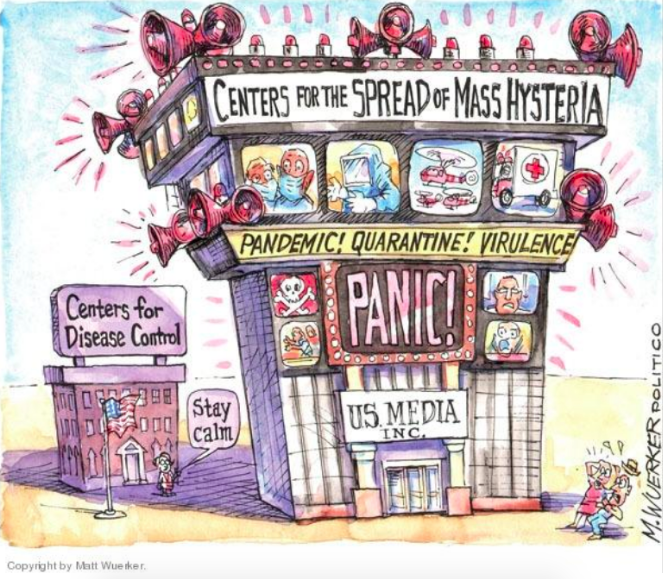The United States is staring at a cinema-worthy apocalypse. You know, with feral animals eating human corpses, mutant plants reoccupying streets and buildings, empty restaurants and malls across the landscape . . .
Well, that last part is true, anyway. Not because of the disease, but rather the hysteria.
You’ve heard the apocalyptic claims. Imperial College in London
estimates as many as 2.2 million U.S. deaths, depending on how drastically the population is locked down, locked out, and locked in. To reduce that figure to a “mere” 1.1 million, we would need to live a maximum-security lifestyle “until a vaccine becomes available (potentially eighteen months or more),” they said. The
cdc has issued an estimate of as many as 1.7 million American deaths.
Do we really need to destroy the country to save it?
Consider that China was taken completely unaware by the virus and, with an unfit healthcare system and poor public hygiene, has so far reported fewer than 3,300 deaths. Their epidemic peaked
over five weeks ago with almost no new cases now. Based on the above predictions, despite a vastly better healthcare system, the United States can expect a per capita death rate about 2,500 times higher than the Middle Kingdom. Seriously, Imperial College?
You could quit reading right there. But please, don’t. The utter insanity here is worth documenting. It’s also worth knowing why even the low-end U.S. estimates are nonsense.
The pandemic is showing signs of slowing worldwide. And that was to be expected per what’s called “Farr’s Law,” which dictates that all epidemics tend to rise and fall in a roughly symmetrical pattern or bell-shaped curve. Ebola, Zika, sars, and aids all followed that pattern. So does the seasonal flu each year. Peaks for covid-19 have already been reported in China, South Korea, and Singapore.
Importantly, Farr’s Law has precious little to do with human interventions such as “social distancing” to “flatten the curve.” It occurs because communicable diseases nab the “low-hanging fruit” first (in this case the elderly with comorbid conditions) but then find subsequent victims harder and harder to reach. Until now, more or less,
covid-19 has been finding that low-hanging fruit in new countries, but the supply is close to running out. While many people assume that the draconian regulations implemented in China are what brought the virus under control, Farr’s Law offers a different explanation. Even
The New York Times admitted that South Korea recovered far more quickly with regulatory measures nowhere near the scale of China’s—although the
Times still attributes that entirely to human intervention, of course, assigning no role to Mother Nature.
When the coronavirus epidemic ends and the public-health zealots inevitably slap themselves on the back for having prevented the nightmare scenarios they themselves cooked up, don’t buy it. This isn’t to say that thorough hand-washing several times a day and not sneezing and coughing in others’ faces won’t help: It will. But the authoritarian and economically devastating measures taken by the United States and other countries are wrecking the world economy. Any feared apocalypse would happen on their account, not the disease’s. Coronavirus has not emptied our streets; government dictates have.
Right now, we’re seeing such a dramatic spike in cases because testing has only recently become readily available in the United States, due to a delay in the cdc developing its own assay. This availability has been almost universally hailed as a good thing, but it has at least two bad aspects.
First, tests will pick up many asymptomatic and mildly symptomatic people, who will be counted as “cases” just as much as those on death’s door. This will further contribute to hysteria. Second, many of those highly mild cases will suddenly develop “nocebo” symptoms (the opposite of placebo), in which negative expectations seem to cause real symptoms. This will only add to the confusion. Nocebo symptoms are psychosomatic but can feel very real. They can definitely mimic covid-19 symptoms like fatigue and shortness of breath. It’s a good guess that hospitals are already seeing their share of the “worried well,” people who were feeling more or less okay before they tested positive and suddenly feel deathly ill.
On the positive side, the more you test, the lower the death rate becomes, because the denominator grows faster than the numerator. Rather than the 3.4% rate the
who touted in early March, the crude
U.S. death rate is
about 1.35%. As testing continues, the rate will drop even further.
So how many deaths can the United States reasonably expect? From what the media tell us, “
Italy’s Coronavirus Crisis Could Be America’s.” Really?
That country so far has had just over 7,500 deaths out of a population of 50 million, but the number of new cases and the number of deaths per day
have peaked, with the highest number coming on March 21.
Still, at this point that’s a stunning 10% crude death rate, by far the highest death percentage in the world, which of course is why the media choose to focus on it almost exclusively. Germany, by contrast, has only about 240 deaths out of a much larger population.
But why is this happening in Italy? Partly because Italy simply doesn’t have a great health care system. Last year, the Nuclear Threat Initiative and the Johns Hopkins Center for Health Security ranked the United States the
best prepared country in the world to handle a pandemic in late 2019. Italy came in thirty-first place.
As
Forbes recently noted,
U.S. hospitals have vastly more
critical care beds per capita than Italy, which in turn has more than South Korea. And you don’t even want to hear about China. Bed pretty much equals floor.
Beyond that, Italy also has the fifth-oldest population in the world; the United States ranks sixty-first. We already knew from
data released by the Chinese Center for Disease Control that
covid-19 preys overwhelmingly upon the old and infirm, with death rates dramatically higher for those aged seventy and older. Further, almost all the elderly dead in that study had “comorbid” conditions of cardiovascular disease, diabetes, or hypertension.
Similarly, a March 17 study in Italy found that the vast majority of those who had died in that country thus far
were over the age of seventy, and virtually all had comorbid conditions; in fact, half of those who died had three or more. Almost nobody under the age of fifty has succumbed, and almost all who have also had serious existing medical conditions. This may reveal something about Italy’s healthcare system, but it’s not a portent of America’s future.
Yet another U.S. advantage is that the disease hit here later than in Italy (and Asia, of course). Spring is in the air. Respiratory viruses usually hate warm, moist, sunny weather. Hence flu arrives in the United States in the fall and disappears by April or May. We know the “common cold” is rare in summer; many colds, in fact, are caused by different coronavirus strains.
This year, the flu peaked in February. It’s possible that, even now, warmer weather is affecting U.S. coronavirus spread. Will it come back in autumn? Probably. But by then many in the population will have had exposure immunity, hospitals will be better prepared, the “worried well” problem will be diminished for lack of novelty, and we’ll have time to see if anything in our arsenal of antivirals and other medicines is truly effective. (No, there will be no vaccine available.)
Meanwhile, it’s very difficult to assess the effectiveness of the restrictive measures blanketing most of the country. We know hermits don’t get contagious diseases, but there’s a reason the term “society of hermits” is an oxymoron. South Korea didn’t need such drastic measures and
Sweden hasn’t used them, even as its neighbor Norway has been praised for early implementation. For its efforts, Norway has been rewarded with twice as many cases per capita and is suddenly suffering its
highest unemployment rate in eighty years.
But as always, we follow the dictates of the public health zealots, the media, and the power-hungry pols. Reality is bitter medicine; hysteria may taste sweeter at first, but it has dubious benefits.
Michael Fumento is an attorney, author, and journalist who has been documenting epidemic hysterias for thirty-five years. He may be reached at fumento@gmail.com.






 .
.